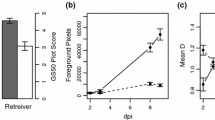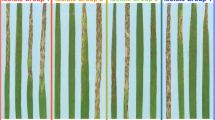Summary
Seedlings of a differential barley (Hordeum vulgare L.) series (21 genotypes) and of six check genotypes were used in the greenhouse to assess variation in virulence among 20 single-spore isolates of the net blotch pathogen. Pyrenophora teres Drechs. f.teres Smedeg., collected from various sites in Finland. The experiment was run twice and symptom expression was recorded on the first three leaves. Analysis of second leaf symptom scores from Run 1 indicated differences in virulence between isolates, all of which were pathogenic, and differential resistance among the barleys. The virulence of P. teres isolates appeared to be conditioned by the host barley from which the isolate derived; the average virulence of isolates collected from a susceptible host was greater than that of isolates collected from a less susceptible host. Results from Run 2 were similar regarding resistance within the barleys, but variation in virulence among the P. teres isolates was not consistent with that from Run 1. CI 9819 caries duplicate genes for resistance to P. teres (Rpt1b and Rpt1c), and CI 7548 possesses Rpt3d. Both genotypes were highly resistant to all isolates. The Rpt1a gene of Tifang (CI4407) conferred resistance to all isolates in Run 2, but only to about half of the isolates in Run 1. The checks, including two of the symptomatically most resistant Nordic barley genotypes, were universally susceptible during these stringent tests. No selective pressure has been placed on Finnish isolates of P. teres through previous deployment of major resistance genes, and it is speculated that any variation in virulence among isolates is likely to be due to a combination of evolutionary forces including, natural selection, random genetic drift and gene flow.
Similar content being viewed by others
References
Bockelman H.E., E.L. Sharp & R.F. Eslick, 1977. Trisomic analysis of genes for resistance to scald and net blotch in several barley cultivars. Can J Bot 55: 2142–2148.
Finlay K.W. & G.N. Wilkinson, 1963. The analysis of adaptation in a plant-breeding programme. Aust J Res 14: 742–754.
Jandel Scientific, 1993. Sigma Plot User's Manual, San Rafael, CA, USA.
Khan T.N., 1969. Inheritance of resistance to net blotch in barley. I. Factors affecting the penetrance and expressivity of gene(s) conditioning host resistance. Can J Genet Cytol 11: 587–591.
Littell, R.C., R.J. Freund & P.C. Spector, 1991. SAS System for Linear Models, Third Edition, Cary, NC.
Mäkelä K., 1975. Occurrence of Helminthosporium species on cereals in Finland in 1971–1973. J Sci Agric Soc Fin 47: 181–217.
McDermott J.M. & B.A. McDonald, 1993. Gene flow in plant pathosystems. Annu Rev Phytopathol 31: 353–373.
McDonald B.A., J.M. McDermott, R.W. Allard & R.K. Webster, 1989. Coevolution of host and pathogen populations in the Hordeum vulgare-Rhynchosporium secalis pathosystem. Proc Natl Acad Sci USA 86: 3924–3927.
Peever T.L. & M.G. Milgroom, 1994. Genetic structure of Pyrenophora teres populations determined with random amplified polymorphic DNA markers. Can J Bot 72: 915–923.
SAS Institute Inc., 1989 SAS/STAT User's Guide, Version 6, Fourth Edition, Volume 2, Cary, NC.
Sato K. & K. Takeda, 1993. Pathogenic variation of Pyrenophora teres isolates collected from Japanese and Canadian spring barley. Bull Res Inst Bioresour Okayama Univ 1: 147–158.
Sato K. & K. Takeda, 1994. Sources of resistance to net blotch in barley germplasm. Bull Res Inst Bioresour Okayama Univ 2: 91–102.
Shipton W.A., T.N. Khan & W.J.R. Boyd, 1973. Net blotch of barley. Rev Plant Pathol 52: 269–290.
Steffenson B.J. & R.K. Webster, 1992a. Pathotype diversity of Pyrenophora teres f. teres on barley. Phytopath 82: 170–177.
Steffenson B.J. & R.K. Webster, 1992b. Quantitative resistance to Pyrenophora teres f. teres in barley. Phytopath 82: 407–411.
Tekauz A., 1985. A numerical scale to classify reactions of barley to Pyrenophora teres. Can J Plant Pathol 7: 181–183.
Tekauz A. & K.W. Buchannon, 1977. Distribution of and sources of resistance to biotypes of Pyrenophora teres in western Canada. Can J Plant Sci 57: 389–395.
Tekauz A. & J.T. Mills, 1974. New types of virulence in Pyrenophora teres in Canada. Can J Plant Sci 54: 731–734.
Thompson J.N. & J.J. Burdon, 1992. Gene-for-gene coevolution between plants and parasites. Nature 360: 121–125.
Tottman D.R. & R.J. Makepeace, 1979. An explanation of the decimal code for the growth stages of cereals, with illustrations. Ann Appl Biol 93: 221–234.
Author information
Authors and Affiliations
Rights and permissions
About this article
Cite this article
Robinson, J., Jalli, M. Diversity among Finnish net blotch isolates and resistance in barley. Euphytica 92, 81–87 (1996). https://doi.org/10.1007/BF00022832
Issue Date:
DOI: https://doi.org/10.1007/BF00022832




